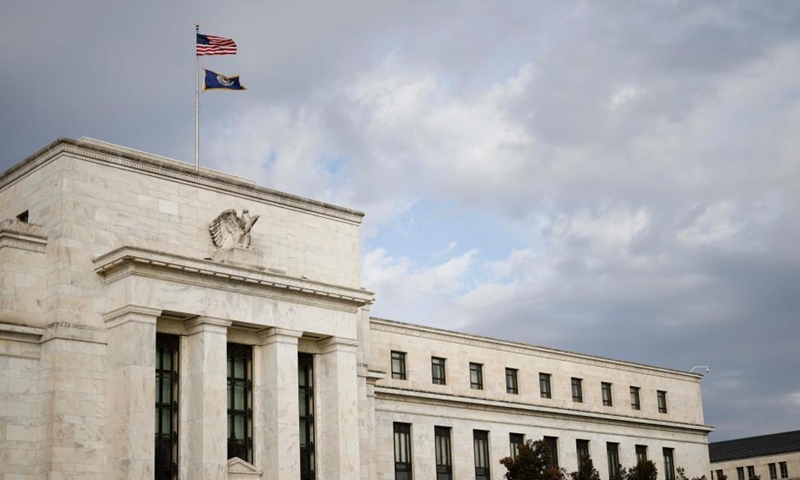US announces sharp rate hike; 'a self-inflicted consequence’

Photo taken on Jan. 25, 2022 shows the US Federal Reserve in Washington, D.C., the United States. Photo:Xinhua
In a desperate move to quell inflation in the US, the Federal Reserve on Wednesday announced its sharpest rate hike in more than two decades.
The rare decision as well as the Fed's aggressive plans to wind down its balance sheet is considered partly a self-inflicted consequence of Washington's reckless imposition of additional tariffs on Chinese goods, a fuel additive to its inflation woes, observers said. A scenario of the US lifting China tariffs is seen as possibly shaving off a conspicuous portion off the red-hot inflation.
The about-face in the US monetary policy stokes fears of US stagflation, they noted, warning against the negative spillover effect of the Fed's policy aggressiveness.
China, for its part, has shown to be well equipped with monetary policy leeway and tools despite the US-led cycle of rate hikes, paving the way for its economic recovery, especially factoring in signs of stabilization in the COVID-19 situation in Shanghai, experts said.
Taste of Washington's own medicine
After a two-day policy meeting ended on Wednesday, the US Federal Open Market Committee (FOMC), the Fed's policymaking body, decided to raise its key fund rates by half a percentage point, or 50 basis points, the largest move since 2000.
In addition, the Fed has plans to begin a balance sheet contraction in June that will drain liquidity of a maximum of $47.5 billion per month. After a three-month run-up, the portfolio reduction will be capped at $95 billion per month from September.
"Inflation remains elevated, reflecting supply and demand imbalances related to the pandemic, higher energy prices, and broader price pressures," read the FOMC statement announcing the rate hike decision.
The US consumer price index (CPI) soared 8.5 percent for the year ending March, official data showed, a four-decade high.
The Wednesday decision followed a 25 basis point rate hike in mid-March, the Fed's first such move since 2018, as the US shifted its policy focus to battling inflation.
US stocks rallied on Wednesday after Fed Chairman Jerome Powell ruled out the likelihood of a larger rate hike. This appears to have fed optimism into Chinese mainland stocks, which derived confidence from a Wednesday statement by the securities regulator that vowed to maintain a stable capital market and bolster the macroeconomy. The flagship Shanghai Composite finished up 0.68 percent at 3,067.76 points on Thursday, starting May on a positive note. Thursday was the first trading day for A shares after a five-day May Day holidays.
While crystallizing its tightening stance - an abrupt change of course after years of scrupulous money printing as the pandemic inflicted heavy damage on the US economy - the Fed made no mention of a significant factor in the rampant inflation, namely the additional tariffs on Chinese products which remain in place under the Joe Biden administration.
Other than its flood irrigation style stimulus, the US' imposition of additional Chinese tariffs is attributed to its runaway inflation, as US consumers have no choice but to foot the bill of part of the added costs in the wake of the tariff increases, veteran financial expert Zhao Qingming told the Global Times on Thursday.
The Biden administration is apparently aware of the lynchpin of the inflation headache.
"All tools are on the table to address rising inflation, including reductions of tariffs on Chinese imports," Reuters reported on Monday, citing US Trade Representative Katherine Tai.
Still, Tai seemed to downplay the deflationary impact of tariff reductions, as she challenged a recent research by the Peterson Institute for International Economics (PIIE) that urged trade liberalization to tame inflation.
"A feasible package of liberalization could deliver a one-time reduction in CPI inflation of around 1.3 percentage points, amounting to $797 per US household, about half the size of pandemic relief in 2021," the PIIE paper said in March.
Former US President Donald Trump's tariff war against China, according to the PIIE paper, inflicted a 16 percent additional average tariff on US businesses and households that bought $506 billion in Chinese items in 2021. "Americans, not Chinese exporters, paid the tariffs," the PIIE said, proposing that eliminating the tariffs "corresponds to a 0.3 percentage point reduction in CPI inflation directly through lower import prices."
In the eyes of Chinese experts, the deflationary impact of the tariff removal is rather underestimated though.
The direct impact of removing added tariffs on Chinese products could lower the US CPI by 1.5 percentage points from the current level, Gao Lingyun, an expert at the Chinese Academy of Social Sciences in Beijing, told the Global Times on Thursday.
It depends on the appeal of US companies and consumers who are victims of the hefty tariffs to determine which products are most likely to have tariffs removed by the US government, Gao said, expecting labor-intensive products to initially make a list of items to be exempted from the additional tariffs.
As the US begins a review of its tariffs on Chinese goods ahead of their July expiration, calls are growing for the US to roll back Trump-era China tariffs.
The top priority for the US is to control inflation. However, single tools such as interest rate hikes alone will not solve the problems. The removal of the added tariffs on some Chinese products could be the next move, Hu Qimu, chief research fellow at the Beijing-based Sinosteel Economic Research Institute, told the Global Times on Thursday.
"If the US wants to further grow its economy, it needs cooperation from other countries, especially the supply chains from China," Hu said, noting much of China and US industries are complementary.
Speaking at a regular news conference in Beijing on Thursday, Foreign Ministry spokesperson Zhao Lijian said that the China-US economic and trade cooperation is essentially about reciprocity and win-win, and there's no winner in a trade or tariff war. The US' unilateral levy of additional tariffs does no good for China, for the US and for the world, Zhao said.
In late April, the Ministry of Commerce also said that the US removing tariffs on Chinese goods is in line with the interests of US firms and consumers.
Chinese and US trade teams are maintaining normal communication, the commerce ministry said.
China maintains policy dependent despite ramifications
While concerns are mounting over the impact of the Fed's drastic rate hikes on global economic stability, hopes are high that China would maintain its monetary policy dependence as the country taps into its sufficient toolbox to bolster its economy amid virus flare-ups.
The US is accustomed to weaponizing its dollar hegemony to make a profit and bully other major economies, Dong Dengxin, director of the Finance and Securities Institute of the Wuhan University of Science and Technology, told the Global Times on Thursday.
When the US economy performs poorly, it tends to soften the dollar with monetary easing to reduce payment pressure on dollar-denominated debt and grab the world's resources and commodities. The move is often followed by a hike in interest rates and the provoking of geopolitical conflicts to force capital to flow to the US, Dong said.
"By doing so, the US government 'harvested' the riches of other nations," Dong said.
An unexpected contraction in the US economy at a 1.4 percent annualized pace in the first quarter also heightens fears of stagflation, worsening the effects of rate hikes which would supposedly cool the US economy, experts said.
As the rest of the world is largely grappling with the fallout of the Fed's rate hike cycle, China is actually in a better position when it comes to monetary policymaking, analysts stressed.
A continued monetary policy easing is well on the cards to shore up the economy amid COVID-19 flare-ups, Zhao said, estimating that there is still room for further cuts in reserve requirements.
China's central bank announced in mid-April a universal 25 basis points of reduction in banks' reserve requirement ratio (RRR) that will release about 530 billion yuan ($83.18 billion) in long-term capital.
Additionally, "the market is still expecting an interest rate cut in May, after China has kept the benchmark loan prime rate unchanged for a third straight month in April," Zhao said.
In a sign of sufficient policy tools, the central bank recently announced the creation of sci-tech innovation re-lending, a one-year new facility totaling 200 billion yuan, a 40 billion yuan re-lending quota for inclusive eldercare, and an additional 100 billion yuan special re-lending facility for the clean use of coal.
Photos
Related Stories
- Coloradans protest against Supreme Court probable reversal on abortion rights
- How will abortion rights fight affect U.S. midterms?
- U.S. blamed for gang violence in El Salvador
- Commentary: Inaction in face of pandemic orphanhood throws U.S. government's credibility into doubt
- Los Angeles police clash with protesters supporting women abortion rights
Copyright © 2022 People's Daily Online. All Rights Reserved.










